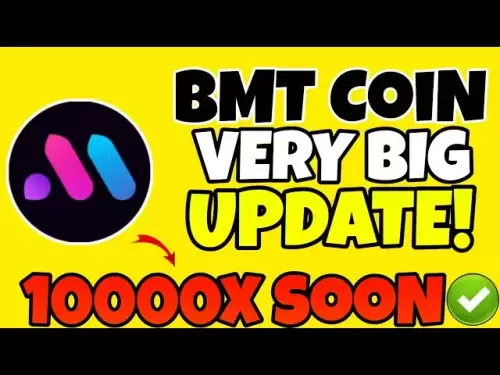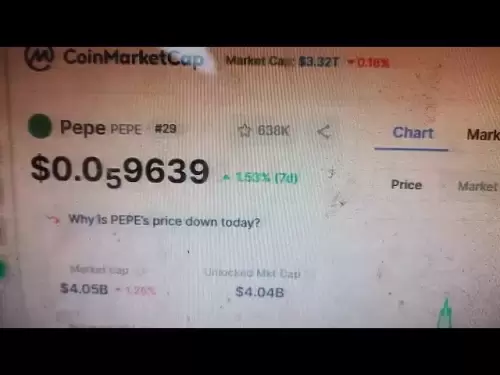-
 Bitcoin
Bitcoin $108,962.3544
0.69% -
 Ethereum
Ethereum $2,563.3189
1.78% -
 Tether USDt
Tether USDt $1.0003
0.00% -
 XRP
XRP $2.2768
2.22% -
 BNB
BNB $661.4562
0.97% -
 Solana
Solana $151.7146
2.47% -
 USDC
USDC $1.0000
0.00% -
 TRON
TRON $0.2847
0.18% -
 Dogecoin
Dogecoin $0.1713
4.43% -
 Cardano
Cardano $0.5848
1.78% -
 Hyperliquid
Hyperliquid $39.5345
-0.06% -
 Sui
Sui $2.9384
1.25% -
 Bitcoin Cash
Bitcoin Cash $492.0864
1.54% -
 Chainlink
Chainlink $13.4271
1.89% -
 UNUS SED LEO
UNUS SED LEO $9.0294
0.07% -
 Avalanche
Avalanche $18.1886
1.61% -
 Stellar
Stellar $0.2430
2.48% -
 Toncoin
Toncoin $2.9054
6.05% -
 Shiba Inu
Shiba Inu $0.0...01186
3.57% -
 Litecoin
Litecoin $88.0187
1.46% -
 Hedera
Hedera $0.1574
1.38% -
 Monero
Monero $315.1335
0.11% -
 Polkadot
Polkadot $3.3994
1.47% -
 Dai
Dai $1.0000
0.00% -
 Ethena USDe
Ethena USDe $1.0002
0.01% -
 Bitget Token
Bitget Token $4.4220
0.86% -
 Uniswap
Uniswap $7.4330
7.03% -
 Pepe
Pepe $0.0...01010
4.10% -
 Aave
Aave $277.8377
2.41% -
 Pi
Pi $0.4572
-0.22%
What does UNI's MVRV ratio exceed 3 mean?
UNI's MVRV ratio exceeding 3 signals potential overvaluation, suggesting investors should monitor closely for possible price corrections.
Apr 27, 2025 at 05:00 am

The MVRV (Market Value to Realized Value) ratio is a key metric used in the cryptocurrency space to gauge the market sentiment and potential overvaluation or undervaluation of a cryptocurrency, such as UNI (Uniswap's native token). When we say that UNI's MVRV ratio exceeds 3, it indicates a specific condition in the market that investors and traders pay close attention to. In this article, we will delve into what the MVRV ratio is, how it is calculated, what it means when it exceeds 3, and why this is significant for UNI.
Understanding the MVRV Ratio
The MVRV ratio is a measure that compares the market value (the total market capitalization) of a cryptocurrency to its realized value (the sum of the last transaction value of each coin). This ratio helps investors understand whether a cryptocurrency is trading at a price that is justified by its underlying value. The formula for the MVRV ratio is as follows:
[ \text{MVRV Ratio} = \frac{\text{Market Value}}{\text{Realized Value}} ]
Calculating UNI's MVRV Ratio
To calculate the MVRV ratio for UNI, you need to gather two pieces of data: the total market capitalization of UNI and the realized value of all UNI tokens. The market capitalization is easily accessible from various cryptocurrency data platforms, while the realized value requires more detailed on-chain data analysis.
- Market Value of UNI: This is the total market capitalization, which is the current price of UNI multiplied by the total supply of UNI tokens in circulation.
- Realized Value of UNI: This is calculated by summing up the value of each UNI token at the time of its last transaction. This data can be obtained from blockchain explorers and on-chain analytics platforms.
Once you have these two values, you can apply the MVRV formula to get the ratio.
What Does an MVRV Ratio Exceeding 3 Mean?
When the MVRV ratio of UNI exceeds 3, it suggests that the market value of UNI is three times higher than its realized value. This condition is often interpreted as a sign of overvaluation. Historically, when the MVRV ratio of a cryptocurrency exceeds 3, it has been seen as an indicator that the asset might be in a bubble or overbought condition. This could mean that the price of UNI may have risen too quickly and could be due for a correction.
Historical Context and Implications for UNI
Looking at historical data, cryptocurrencies that have seen their MVRV ratio exceed 3 have often experienced significant price corrections shortly thereafter. For UNI, this could mean that investors should be cautious and consider taking profits if they believe the market is overheating. It's important to note that while an MVRV ratio above 3 can be a warning sign, it does not guarantee a price drop. Market dynamics can be influenced by a variety of factors, including broader market sentiment, regulatory news, and technological developments within the Uniswap ecosystem.
Using MVRV Ratio for Investment Decisions
Investors can use the MVRV ratio as part of their broader analysis when making investment decisions about UNI. Here are some steps to consider:
- Monitor the MVRV Ratio: Keep an eye on the MVRV ratio of UNI through reliable on-chain analytics platforms.
- Compare Historical Data: Look at historical data to see how UNI has performed in the past when its MVRV ratio exceeded 3.
- Diversify Your Portfolio: If the MVRV ratio is high, consider diversifying your investments to mitigate risk.
- Set Stop-Loss Orders: If you hold UNI, consider setting stop-loss orders to protect your investment from potential downturns.
Limitations of the MVRV Ratio
While the MVRV ratio is a useful tool, it is not without its limitations. The ratio does not take into account external factors such as macroeconomic conditions, regulatory changes, or technological advancements within the Uniswap platform. Additionally, the realized value can be skewed by large transactions, which might not accurately reflect the overall market sentiment.
Practical Application: Using On-Chain Analytics Platforms
To monitor UNI's MVRV ratio, you can use various on-chain analytics platforms. Here's how you can do it using one such platform:
- Visit the Platform: Go to an on-chain analytics platform like Glassnode or Coin Metrics.
- Select UNI: Navigate to the section where you can select UNI as the cryptocurrency you want to analyze.
- Find MVRV Data: Look for the MVRV ratio data, which is usually available in the metrics or analytics section.
- Analyze the Data: Check the current MVRV ratio and compare it with historical data to understand the trend.
Interpreting the Data
When interpreting the MVRV ratio, consider the following points:
- Short-Term vs. Long-Term Trends: A high MVRV ratio might not be as concerning if it's part of a long-term upward trend rather than a short-term spike.
- Market Context: Understand the broader market context, including other cryptocurrencies and overall market sentiment.
- Volume and Liquidity: High trading volumes and liquidity can sometimes support higher MVRV ratios without immediate corrections.
Frequently Asked Questions
Q: Can the MVRV ratio be used for other cryptocurrencies besides UNI?
A: Yes, the MVRV ratio can be applied to any cryptocurrency that has sufficient on-chain data available. It's a versatile metric used across the crypto market to assess valuation.
Q: How frequently should I check the MVRV ratio for UNI?
A: It's advisable to check the MVRV ratio at least weekly, but during periods of high volatility, daily checks might be more beneficial to stay informed about potential market shifts.
Q: Is there a specific MVRV ratio that indicates it's a good time to buy UNI?
A: While there's no definitive "buy" signal from the MVRV ratio alone, an MVRV ratio below 1 can indicate that UNI might be undervalued and could be a good time to consider buying. However, always combine this with other analysis methods.
Q: Can the MVRV ratio predict long-term trends for UNI?
A: The MVRV ratio is better suited for identifying short-term overvaluation or undervaluation. For long-term trends, it should be used in conjunction with other fundamental and technical analysis tools.
Disclaimer:info@kdj.com
The information provided is not trading advice. kdj.com does not assume any responsibility for any investments made based on the information provided in this article. Cryptocurrencies are highly volatile and it is highly recommended that you invest with caution after thorough research!
If you believe that the content used on this website infringes your copyright, please contact us immediately (info@kdj.com) and we will delete it promptly.
- Litecoin Breakout Watch: What Traders Need to Know Now
- 2025-07-06 16:50:13
- Bitcoin, Solana, Ethereum: Decoding the Latest Buzz on the Blockchain
- 2025-07-06 16:50:13
- Widnes Resident's 50p Could Be Your Ticket to Easy Street: Rare Coin Mania!
- 2025-07-06 16:55:13
- Bitcoin, Solaris Presale, and Token Rewards: What's the Buzz?
- 2025-07-06 16:55:13
- Ethereum Under Pressure: Price Drop Amid Global Uncertainties
- 2025-07-06 17:00:13
- XRP, SEC Case, and Prosperity: A New Era for XRP Holders?
- 2025-07-06 17:10:13
Related knowledge

How to customize USDT TRC20 mining fees? Flexible adjustment tutorial
Jun 13,2025 at 01:42am
Understanding USDT TRC20 Mining FeesMining fees on the TRON (TRC20) network are essential for processing transactions. Unlike Bitcoin or Ethereum, where miners directly validate transactions, TRON uses a delegated proof-of-stake (DPoS) mechanism. However, users still need to pay bandwidth and energy fees, which are collectively referred to as 'mining fe...

USDT TRC20 transaction is stuck? Solution summary
Jun 14,2025 at 11:15pm
Understanding USDT TRC20 TransactionsWhen users mention that a USDT TRC20 transaction is stuck, they typically refer to a situation where the transfer of Tether (USDT) on the TRON blockchain has not been confirmed for an extended period. This issue may arise due to various reasons such as network congestion, insufficient transaction fees, or wallet-rela...

How to cancel USDT TRC20 unconfirmed transactions? Operation guide
Jun 13,2025 at 11:01pm
Understanding USDT TRC20 Unconfirmed TransactionsWhen dealing with USDT TRC20 transactions, it’s crucial to understand what an unconfirmed transaction means. An unconfirmed transaction is one that has been broadcasted to the blockchain network but hasn’t yet been included in a block. This typically occurs due to low transaction fees or network congestio...

How to check USDT TRC20 balance? Introduction to multiple query methods
Jun 21,2025 at 02:42am
Understanding USDT TRC20 and Its ImportanceUSDT (Tether) is one of the most widely used stablecoins in the cryptocurrency market. It exists on multiple blockchain networks, including TRC20, which operates on the Tron (TRX) network. Checking your USDT TRC20 balance accurately is crucial for users who hold or transact with this asset. Whether you're sendi...

What to do if USDT TRC20 transfers are congested? Speed up trading skills
Jun 13,2025 at 09:56am
Understanding USDT TRC20 Transfer CongestionWhen transferring USDT TRC20, users may occasionally experience delays or congestion. This typically occurs due to network overload on the TRON blockchain, which hosts the TRC20 version of Tether. Unlike the ERC20 variant (which runs on Ethereum), TRC20 transactions are generally faster and cheaper, but during...

The relationship between USDT TRC20 and TRON chain: technical background analysis
Jun 12,2025 at 01:28pm
What is USDT TRC20?USDT TRC20 refers to the Tether (USDT) token issued on the TRON blockchain using the TRC-20 standard. Unlike the more commonly known ERC-20 version of USDT (which runs on Ethereum), the TRC-20 variant leverages the TRON network's infrastructure for faster and cheaper transactions. The emergence of this version came as part of Tether’s...

How to customize USDT TRC20 mining fees? Flexible adjustment tutorial
Jun 13,2025 at 01:42am
Understanding USDT TRC20 Mining FeesMining fees on the TRON (TRC20) network are essential for processing transactions. Unlike Bitcoin or Ethereum, where miners directly validate transactions, TRON uses a delegated proof-of-stake (DPoS) mechanism. However, users still need to pay bandwidth and energy fees, which are collectively referred to as 'mining fe...

USDT TRC20 transaction is stuck? Solution summary
Jun 14,2025 at 11:15pm
Understanding USDT TRC20 TransactionsWhen users mention that a USDT TRC20 transaction is stuck, they typically refer to a situation where the transfer of Tether (USDT) on the TRON blockchain has not been confirmed for an extended period. This issue may arise due to various reasons such as network congestion, insufficient transaction fees, or wallet-rela...

How to cancel USDT TRC20 unconfirmed transactions? Operation guide
Jun 13,2025 at 11:01pm
Understanding USDT TRC20 Unconfirmed TransactionsWhen dealing with USDT TRC20 transactions, it’s crucial to understand what an unconfirmed transaction means. An unconfirmed transaction is one that has been broadcasted to the blockchain network but hasn’t yet been included in a block. This typically occurs due to low transaction fees or network congestio...

How to check USDT TRC20 balance? Introduction to multiple query methods
Jun 21,2025 at 02:42am
Understanding USDT TRC20 and Its ImportanceUSDT (Tether) is one of the most widely used stablecoins in the cryptocurrency market. It exists on multiple blockchain networks, including TRC20, which operates on the Tron (TRX) network. Checking your USDT TRC20 balance accurately is crucial for users who hold or transact with this asset. Whether you're sendi...

What to do if USDT TRC20 transfers are congested? Speed up trading skills
Jun 13,2025 at 09:56am
Understanding USDT TRC20 Transfer CongestionWhen transferring USDT TRC20, users may occasionally experience delays or congestion. This typically occurs due to network overload on the TRON blockchain, which hosts the TRC20 version of Tether. Unlike the ERC20 variant (which runs on Ethereum), TRC20 transactions are generally faster and cheaper, but during...

The relationship between USDT TRC20 and TRON chain: technical background analysis
Jun 12,2025 at 01:28pm
What is USDT TRC20?USDT TRC20 refers to the Tether (USDT) token issued on the TRON blockchain using the TRC-20 standard. Unlike the more commonly known ERC-20 version of USDT (which runs on Ethereum), the TRC-20 variant leverages the TRON network's infrastructure for faster and cheaper transactions. The emergence of this version came as part of Tether’s...
See all articles

























































































